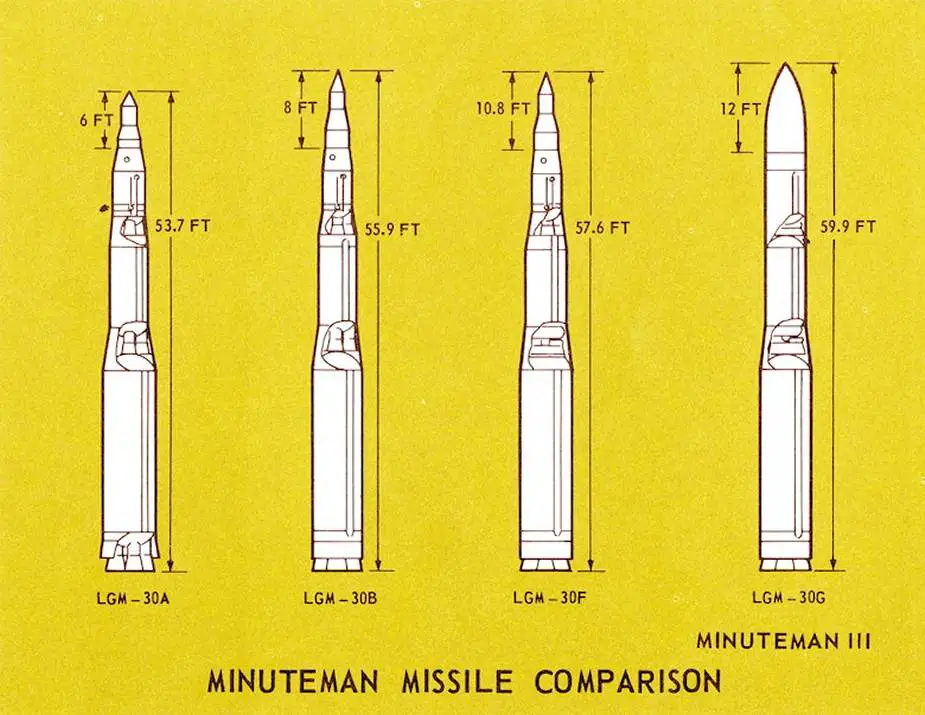Breaking news
Northrop Grumman awarded US Air Force USD 3.8 Bn contract for Minuteman III ICBM support.
Northrop Grumman Systems, Hill Air Force Base, Utah, has been awarded a $3,860,000,000 indefinite-delivery/indefinite-quantity contract for Minuteman III Intercontinental Ballistic Missile ground subsystems support. This contract provides for sustaining engineering, maintenance engineering, test and assessment, modification of systems and equipment, software maintenance, developmental engineering, production engineering, repair and procurement.
Follow Army Recognition on Google News at this link

This comparison chart appeared in May 1968. It introduced Minuteman personnel to the latest missile. In the designation LGM-30G, L means silo-launched, G means surface attack, and M stands for guided missile. (Illustration source: U.S. Air Force)
Work will be performed at Hill AFB, Utah; Vandenberg AFB, California; Malmstrom AFB, Montana; Minot AFB, North Dakota; FE Warren AFB, Wyoming; and Offutt AFB, Nebraska. The work is expected to be completed on July 6, 2039.
This award is the result of a competitive acquisition with two offers received. Fiscal 2021 operation and maintenance funds in the amount of $500,000 are being obligated at the time of award on the first task order. Air Force Nuclear Weapons Center, Hill AFB, Utah, is the contracting activity.
The LGM-30 Minuteman is a land-based intercontinental ballistic missile (ICBM), in service with the U.S. Air Force Global Strike Command. As of 2021, the LGM-30G Minuteman III version is the only land-based ICBM in service in the United States and represents the land leg of the U.S. nuclear triad, along with the Trident submarine-launched ballistic missile (SLBM) and nuclear weapons carried by long-range strategic bombers.
Development of the Minuteman began in the mid-1950s when basic research indicated that a solid-fuel rocket motor could stand ready to launch for long periods of time, in contrast to liquid-fueled rockets that required fueling before launch and so might be destroyed in a surprise attack. The missile was named for the Colonial Minutemen of the American Revolutionary War, who could be ready to fight on short notice.
The Minuteman entered service in 1962 as a deterrence weapon that could hit Soviet cities with a second strike and counter value counterattack if the U.S. was attacked. However, the development of the United States Navy (USN) UGM-27 Polaris, which addressed the same role, allowed the Air Force to modify the Minuteman, boosting its accuracy enough to attack hardened military targets, including Soviet missile silos. The Minuteman-II entered service in 1965 with a host of upgrades to improve its accuracy and survivability in the face of an anti-ballistic missile (ABM) system the Soviets were known to be developing. In 1970, the Minuteman-III became the first deployed ICBM with multiple independently targetable reentry vehicles (MIRV): three smaller warheads that improved the missile's ability to strike targets defended by ABMs. They were initially armed with the W62 warhead with a yield of 170 kilotons.
By the 1970s, 1,000 Minutemen were deployed. This force has shrunk to 400 Minuteman-III missiles as of September 2017 deployed in missile silos around Malmstrom AFB, Montana; Minot AFB, North Dakota; and F.E. Warren AFB, Wyoming. Minuteman III will be progressively replaced by the new Ground-Based Strategic Deterrent (GBSD) ICBM from 2027 onwards to be built by Northrop Grumman.



















